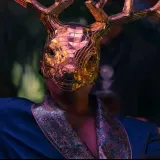Case File #013: The Black-Eyed Children – Do Not Let Them In
Status: Unverified Phenomenon – Active Reports Ongoing
Date Filed: 1996 (First Known Report)
Last Reviewed: May 31, 2025
Location: Global – Predominantly USA & UK
Subjects: Multiple Witnesses – Unknown Entities Resembling Children
Filed Under: Paranormal Phenomena – Human Encounters – Modern Urban Legends
Access Level: Open – Firsthand Accounts Available
Introduction: The Knock at the Door
It’s late at night. You're home alone. There’s a knock at the door—slow, deliberate. You check through the peephole and see two children standing outside. They're wearing plain clothes, sometimes hoodies, sometimes old-fashioned coats. They speak softly:
"Can we come in? Our parents will be here soon."
"We need to use your phone."
But something feels wrong. You feel cold. Afraid. Your instincts scream no.
Then you see it. Their eyes—completely black. No sclera, no iris, no whites. Just pure, unbroken void.
These are the Black-Eyed Children—a modern-day phenomenon that walks the razor's edge between urban legend, extraterrestrial hypothesis, demonic theory, and mass hysteria.
And the warnings are always the same:
“Do not let them in.”
The First Recorded Encounter
While scattered reports date back further, the first widely publicized account came from Brian Bethel, a journalist in Abilene, Texas, in 1996. According to Bethel, he was sitting in his car in a parking lot when two boys—around 10–14 years old—knocked on his window.
They asked for a ride home to get money so they could see a movie. Bethel described a deep, primal fear that overwhelmed him. The boys insisted:
"We can’t come in unless you say it’s okay."
He noticed their eyes were pure black. Terrified, he sped away.
That night, he shared the story on a message board. It went viral before “viral” even existed.
More stories began to surface. Dozens. Then hundreds.
Consistent Traits Across the Globe
Whether in Texas, rural England, suburban Australia, or Eastern Europe—the reports share uncanny consistency.
✅ Common Characteristics:
- Age Range: Usually between 6–16 years old.
- Skin Tone: Pale or sickly gray.
- Clothing: Outdated or mismatched clothes. Often hooded.
- Speech: Monotone. Robotic. Formal, sometimes overly polite.
- Requests: To come in. To use a phone. A ride. A drink of water.
- Eyes: Jet black. No whites. Often hidden at first—until revealed.
Witnesses report overwhelming feelings of dread, nausea, or paralysis. Some say the air becomes heavy, electronics malfunction, animals panic.
And always—they must be invited in.
Theories: What Are They?
This is where things get even darker. No one agrees on what the Black-Eyed Children actually are—but here are the leading (and chilling) theories:
1. Extraterrestrial Entities
Some believe the children are alien-human hybrids. Their behavior and appearance suggest something mimicking humanity, but failing the details. Think: close, but off. Their psychic pressure and emotional suppression also align with UFO contactee experiences.
2. Demonic or Supernatural Beings
The insistence on being “invited in” draws parallels with vampire lore and demonic legends. In many spiritual belief systems, invitation grants permission to cross boundaries—physical or metaphysical. Once inside, people report intense illness, misfortune, or even death.
3. Interdimensional Travelers
Another theory posits they are beings from a parallel reality—slipping through cracks in the veil. They are confused, stuck, or hunting. The black eyes? A sign of non-human biology or sensory adaptation.
4. Government Experiments or Mind Control Agents
More grounded theories suggest social engineering experiments. Why are so many reports from military-adjacent towns or areas with heavy surveillance? Could this be a fear test? A psychological probe?
Documented Encounters
📍Vermont, 2016:
An elderly couple awoke to find two children on their porch during a snowstorm, asking to come in and wait for their parents. The couple let them in. The power went out. Their dog hid.
After a while, the kids stood and said, “Our parents are here.” A black car with two tall, pale men pulled up.
The couple suffered nosebleeds, skin conditions, and both were later diagnosed with rare cancers.
📍Ohio, 2013:
A teenager home alone answered a knock to find a young girl with black eyes asking to come in. He slammed the door shut and locked it. His nose began bleeding immediately.
Weeks later, his dog died. He reported nightmares of children standing at the foot of his bed.
📍UK, 2005:
Multiple sightings in Cannock Chase. Children seen in graveyards, woods, and roadsides. Witnesses described electrical disturbances, panic attacks, and lost time after encounters.
“Don’t Let Them In” – The Golden Rule
In every account, the people who did not let them in survived with minimal lingering effects. But those who allowed them into their homes or vehicles reported:
- Sudden, chronic illnesses
- Depression or suicidal thoughts
- Paranormal activity in the home
- Deaths of pets or loved ones
- Persistent dreams or hallucinations
And worst of all:
The feeling of always being watched—by small, dark eyes.
The Modern Haunting
The Black-Eyed Children phenomenon has not slowed down. Reports continue to surface—many in whispers, some anonymous, some public. The internet is littered with firsthand stories, audio retellings, and even doorbell camera footage (often mysteriously corrupted).
Podcasts like Monsters Among Us and The Black Tapes have dedicated episodes to them. Even mainstream paranormal researchers like David Weatherly have written entire books documenting encounters.
Still, no one has captured them, proved them, or even explained them.
Which begs the question:
If they’re just a story… why are so many people still so afraid to open the door?
Conclusion: If You Hear the Knock…
You may think you'd never fall for it.
But they look like lost children.
They speak like lost children.
They ask for your help.
And all they need is for you to say:
"Yes, you can come in."
Once you do, nothing will ever be the same again.
References
All sources used in this case are listed in the References Archive. Each link corresponds to verified data, public records, or expert documentation.

